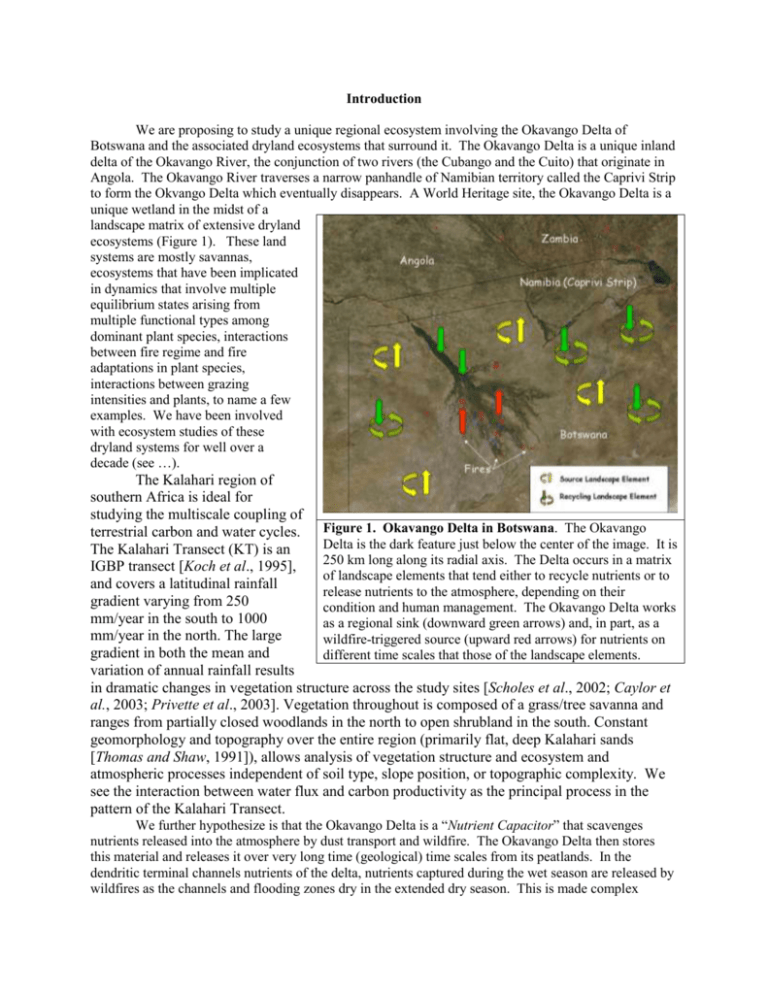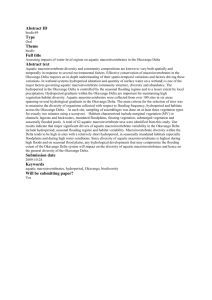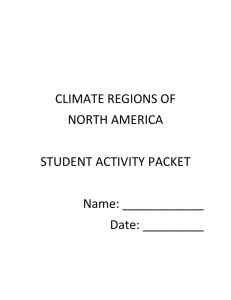Introduction - Center for Regional Environmental Studies
advertisement

Introduction We are proposing to study a unique regional ecosystem involving the Okavango Delta of Botswana and the associated dryland ecosystems that surround it. The Okavango Delta is a unique inland delta of the Okavango River, the conjunction of two rivers (the Cubango and the Cuito) that originate in Angola. The Okavango River traverses a narrow panhandle of Namibian territory called the Caprivi Strip to form the Okvango Delta which eventually disappears. A World Heritage site, the Okavango Delta is a unique wetland in the midst of a landscape matrix of extensive dryland ecosystems (Figure 1). These land systems are mostly savannas, ecosystems that have been implicated in dynamics that involve multiple equilibrium states arising from multiple functional types among dominant plant species, interactions between fire regime and fire adaptations in plant species, interactions between grazing intensities and plants, to name a few examples. We have been involved with ecosystem studies of these dryland systems for well over a decade (see …). The Kalahari region of southern Africa is ideal for studying the multiscale coupling of terrestrial carbon and water cycles. Figure 1. Okavango Delta in Botswana. The Okavango Delta is the dark feature just below the center of the image. It is The Kalahari Transect (KT) is an 250 km long along its radial axis. The Delta occurs in a matrix IGBP transect [Koch et al., 1995], of landscape elements that tend either to recycle nutrients or to and covers a latitudinal rainfall release nutrients to the atmosphere, depending on their gradient varying from 250 condition and human management. The Okavango Delta works mm/year in the south to 1000 as a regional sink (downward green arrows) and, in part, as a mm/year in the north. The large wildfire-triggered source (upward red arrows) for nutrients on gradient in both the mean and different time scales that those of the landscape elements. variation of annual rainfall results in dramatic changes in vegetation structure across the study sites [Scholes et al., 2002; Caylor et al., 2003; Privette et al., 2003]. Vegetation throughout is composed of a grass/tree savanna and ranges from partially closed woodlands in the north to open shrubland in the south. Constant geomorphology and topography over the entire region (primarily flat, deep Kalahari sands [Thomas and Shaw, 1991]), allows analysis of vegetation structure and ecosystem and atmospheric processes independent of soil type, slope position, or topographic complexity. We see the interaction between water flux and carbon productivity as the principal process in the pattern of the Kalahari Transect. We further hypothesize is that the Okavango Delta is a “Nutrient Capacitor” that scavenges nutrients released into the atmosphere by dust transport and wildfire. The Okavango Delta then stores this material and releases it over very long time (geological) time scales from its peatlands. In the dendritic terminal channels nutrients of the delta, nutrients captured during the wet season are released by wildfires as the channels and flooding zones dry in the extended dry season. This is made complex because the rivers that supply the Delta flood in the Angolan wet season which occurs the Delta’s dry season; because the climate of southern Africa has a periodic semi-decadal rain cycle; because Hippopotami (Hippopotamus amphibius) can make channels in the levees that contain the terminal streams and reroute kilometers of stream channels overnight. Our study is motivated by the belief that the combination of conditions produced by the Kalahari Sands region of Southern Africa provides a unique context to understand regional ecosystem dynamics and human alterations of these dynamics. We have four central hypotheses: 1. The dryland region surrounding the Okavango Delta are controlled in their spatial patterns over local to regional scales by water-flux/carbon-flux related processes 2. The dryland systems that surround the Okavango Delta exist in bi-stable states that either release or recycle nutrients. 3. The Okavango Delta scavenges and stores nutrients regionally. 4. The Okavango Delta releases stored nutrients over a range of time scales. Revealing the underlying hypotheses to test and understand these hypotheses will provide a context to understand the effects of human interactions with the regional systems that also occur in multiple space and time scales. Background on Central Hypotheses\ Scale, Vegetation Patterns, and Water/CO2 Flux — At the local scale (~100-101 m), the patchy distribution of trees, grass, and bare soil is associated with local heterogeneities in soil properties and water availability, which, in turn, determine the composition and structure of landscape-scale (~101-104 m) vegetation (Figure 2). Thus, local scale soil moisture-vegetation feedbacks acting in conjunction with the rainfall regime determines both the productivity of savanna ecosystems and the land cover conditions (e.g., albedo, surface roughness, sensible and latent heat fluxes). These, in turn, affect the landatmosphere coupling at the regional scale (~104-106 m). Regional scale land-atmosphere interactions contribute to the regional rainfall regime, with consequent effects on the strength of local scale feedbacks and vegetation dynamics. At the local level, the interaction between vegetation and soil moisture determines the vegetation structure and function in arid and semiarid ecosystems [e.g., Noy-Meir, 1973; Walker et al., 1981; Scholes and Archer, 1997]. Subcanopy soils are frequently found to be moister than intercanopy areas [Walker et al., 1981; Agnew and Wilson, 1992; Greene et. al., Figure 2. Spatial scales and multi-scale feedbacks considered for water and vegetation coupling in the Kalahari region of southern Africa. 1994, 2001; Scholes and Archer, 1997; Zeng et al., 1996; 2004], suggesting the existence of a positive feedback between vegetation and soil water content that may lead to pattern formation [Lefer and Lejeune, 1997; von Hardenberg et al., 2001; HilleRisLambers et al., 2001] and to the emergence of multiple stable states in the temporal and spatial dynamics of vegetation [Walker et al., 1981; Zeng et al. 2004; Rietkerk and van de Koppel, 1997; Scheffer et al., 2001]. Recent theories [e.g., Lejeune et al., 2002] suggest that the subcanopy environment facilitates seedling establishment, whereas competition for water between canopies may make intercanopy areas unsuitable for vegetation establishment and growth [Casper et al., 2003]. These facilitation-competition processes can explain the composition of vegetation in water-limited ecosystems [e.g., Couteron and Lejeune, 2001; Caylor et al., 2006]. Other vegetation-water feedbacks in savanna ecosystems operate at the regional scale. Vegetation affects precipitation through evapotranspiration [Xue, 1997; Zeng et al., 1999; Wang and Eltahir, 2000; Xue, 2006]. This positive feedback effect may promote complex behavior such as hysteresis in the coupling between climate and vegetation in savanna ecosystems [Sternberg, 2001]. Soil moisture dynamics alone may be unable to explain this feedback at this large scale. In fact, it has been suggested that in semi-arid environments the feedback between soil moisture and rainfall may be negative [e.g., Findell and Eltahir, 2003; Cook et al., in press], due to surface cooling and the enhancement of subsidence in the air masses overlying wetter soil surfaces. Consideration of how these processes operate across scales and interact dynamically has been missing from previous studies of local and regional-scale feedback effects. For instance, feedbacks between vegetation and rainfall at the regional scale can be influenced by landscape-level surface heterogeneity, which is known to affect the development of the convective boundary layer [e.g., Avissar and Schmidt, 1998]. Operating across scales in the opposite direction are feedbacks that arise from the canopy-scale distribution of soil moisture, the strength of which are impacted by regional-scale meteorological processes. Trends and fluctuations in total annual rainfall and changes in the number and intensity of rainfall events may weaken or strengthen local-scale feedbacks. The effect on landscape and regional scale dynamics remains poorly understood, as it is not clear whether interactive processes occurring at different scales may lead to self-sustained changes both in vegetation and rainfall regime. Thus, despite the relatively rich literature on savanna dynamics [e.g., Walker and Noy-Meir, 1982; Walker et al., 1981; Scholes and Walker, 1993; Scholes and Archer, 1997] the stability and resilience of these ecosystems remains for the most part understudied with respect to multiple scale interactions with hydrometeorological processes.







